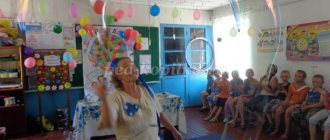In Russia, there has been a law in force for more than 7 years, according to which kindergartens must create a special environment for the development of children with disabilities. We tell you what conditions children with disabilities need and how to organize work with “special” children in preschool.
- Disability and Disability: The Difference
- Where can children with disabilities study?
- What conditions are needed for children with disabilities in kindergartens?
- Forms and methods of work of a teacher with children with disabilities
- Benefits and additional payments for teachers working with children with disabilities
Disability and Disability: What's the Difference?
Children with disabilities are often confused or compared with children with disabilities. These are different concepts and it is important to understand their differences.
A child with disabilities has a regular or temporary deviation in physical or psychological development. For example, he has poor vision or hearing, stutters or has other speech impairments, is mentally retarded, or suffers from autism. Such disorders may be temporary or permanent, mild or severe. As the child develops, they may completely become a thing of the past. The diagnosis of “disability” is not always made by a doctor; it only means that this baby is special and needs an individual approach.
Disability involves significant impairment of body functions. They could be the result of an injury or birth defect in the child. These deviations are difficult to eliminate or cannot be eliminated, so the diagnosis is not removed from the child for years, and sometimes throughout his life. Disability is established by expert doctors at a medical and social commission, has an official status and presupposes the availability of benefits and payments to the child’s parents.
Children with disabilities and disabled children need special conditions for development and learning, attention and care. They are trained using a similar methodology, the features of which depend on the type and severity of the disease.
Socialization of children with disabilities in preschool educational institutions: from theory to practice
Bibliographic description:
Socialization of children with disabilities in preschool educational institutions: from theory to practice / T. V. Reznichenko, A. Yu. Karnaushchenko, O. Yu. Sochneva [and others]. — Text: immediate // Education: past, present and future: materials of the VI International. scientific conf. (Krasnodar, May 2022). - Krasnodar: Novation, 2022. - pp. 18-21. — URL: https://moluch.ru/conf/ped/archive/330/15041/ (access date: 01/19/2022).
The research work reveals the experience of preschool educational institutions and contains a description of a model of successful socialization of children with disabilities tested in practice, generalizes theoretical and practical developments on the organization of a single integrated space for the socialization of pupils with developmental disabilities.
The material presented in the article will be useful to teachers of educational organizations of various types working with children with disabilities.
Key words: socialization, optimal model, preschooler with disabilities, integrative field, concept of social development.
MADOU "Combined Kindergarten No. 200" is a combined educational organization that provides special (correctional) services for children with disabilities. In the preschool educational institution there are 4 correctional groups for pupils with disabilities who have various disabilities (mental developmental disabilities, mental disabilities, autism spectrum disorder, TMPD). Most children have the status of a disabled child.
Kindergarten is an open educational space, the task of which is to develop the universal social abilities of our pupils, mastering social culture, norms of communication and interaction with peers, parents, preschool teachers, taking into account the specifics of their individual and psychophysical capabilities.
The main problem of a child with disabilities is the disruption of his connection with the world, the lack of contacts with peers and adults, limited communication, the inability to navigate the surrounding life, observing certain rules and norms of behavior, the inability to understand the meaning of a number of cultural, moral and ethical values society.
Many preschoolers with disabilities are unable to independently enter the sphere of social relations and master communication skills, as they have difficulties in adaptation, social-emotional deprivation, insufficient or distorted development of voluntary regulation of emotional and behavioral manifestations, increased anxiety, uncertainty, low or high self-esteem, lack of initiative, lack of independence, lack of curiosity and activity.
The above listed features of preschoolers with disabilities determine the relevance of this research work.
The goal of the work is to create conditions for the successful socialization of preschool children with disabilities.
The preschool teachers identified the following tasks:
– increasing the professional competence of all participants in the socialization process;
– development and testing of an optimal model of correctional and educational activities as a single integrated field for the socialization of preschool children with disabilities;
– development of a system of diagnostic tools and criteria for assessing the level of formation of the socialization process of preschoolers with disabilities;
– exchange of experience, methodological developments, recommendations for various categories of teaching staff on the use of the socialization system for preschool children in practice.
Object of study: pupils of correctional groups of preschool educational institutions with disabilities.
Subject of research: problems of socialization of children with disabilities in society.
Practical significance: creation and testing of an optimal model of correctional and educational activities as a single integrated field for the socialization of preschoolers with disabilities.
hypothesis : the process of socialization of preschoolers with disabilities will have positive dynamics if an effective model of a single integrated space is created in the preschool educational institution.
Research methods: theoretical (study and analysis of literature, regulations); sociological (conversations, surveys); pedagogical experiment, monitoring, analysis, generalization and systematization.
Our preschool institution has paid attention to this problem and has been deliberately dealing with it for many years. (“Municipal Experimental Site” 2011–2012; “Municipal Innovation Site” 2013–2014; City Panorama of Innovation Experience “Virtual Site” 2015, 2016, 2017)
Based on our many years of experience, we have developed an optimal model of interaction between all participants in the correctional and educational process for the successful socialization of children with disabilities in an educational institution.
The basis for the development of the optimal model was the Concept of social development of preschool children “On the Road of Goodness”, ed. L. V. Kolomiychenko. In this concept, socialization is considered as “the process of familiarization with social culture, social adaptation of the individual in society, individualization as a process of isolation, the formation of universal social abilities that characterize the degree of social independence of the individual, and cultural creativity.” [1]
In their work they relied on general scientific pedagogical approaches:
– axiological approach (identification of priority communicative, cognitive or subject-practical values in the education, upbringing and self-development of a preschooler with disabilities);
– cultural approach (taking into account national values and traditions, introducing the child to the main components of human culture); [2]
– humanistic approach (recognition of the child as an individual, focus on his needs and interests, rights and freedoms, psychological comfort);
– anthropological approach (psychological and pedagogical diagnostics in determining the dynamics of social development of a preschooler with disabilities);
– multi-subjective approach (taking into account the specifics and influence of the micro- and macroenvironment on a child with disabilities);
– system-structural approach (organization of an integral pedagogical system of correctional, developmental and educational environment);
– an integrated approach (integration of all components of the pedagogical process: cognitive, speech, social-communicative, artistic-aesthetic, physical);
– activity approach (the child’s relationship with the outside world, the realization of his needs in various types of activities);
– environmental approach (organization of a socializing subject-educational space).
Rice. 1. Model of socialization of preschool children with disabilities in preschool educational institutions
At the center of our model is a child (a preschooler with disabilities), around him all subjects of the social environment are involved and are in close partnership and interconnected: the community of peers, family, employees, and social partners of the preschool educational institution.
Interaction with each of these groups leaves an indelible mark on the child’s mind and influences his personal and social development.
The cooperation of all subjects of interaction is aimed at organizing a single integrated space for the socialization of pupils with disabilities, which includes:
– regulatory and legal support of the process;
– software and methodological equipment;
– consultative and diagnostic support for pupils and families;
– organization of a professional, pedagogically appropriate educational environment;
– creation of a comfortable, accessible, variable subject-spatial environment;
– organization of leisure activities.
We see the effectiveness of this model in the successful adaptation and socialization of our students in a kindergarten, optimization of the correctional and developmental field as a whole, in nurturing tolerance among all participants in the educational process, increasing the level of pedagogical competence of the kindergarten staff and the active participation of parents in the life of the preschool educational institution.
During the control period of 2016, 2022, 2022, three control sections of the final monitoring of pupils of correctional preparatory groups of preschool educational institutions were carried out.
32 graduates - 2016, 28 graduates - 2022, 34 graduates - 2018.
The results are presented in the diagram.
Results of monitoring the integrative qualities of preschool educational institution graduates for the control period 2016–2018 (%)
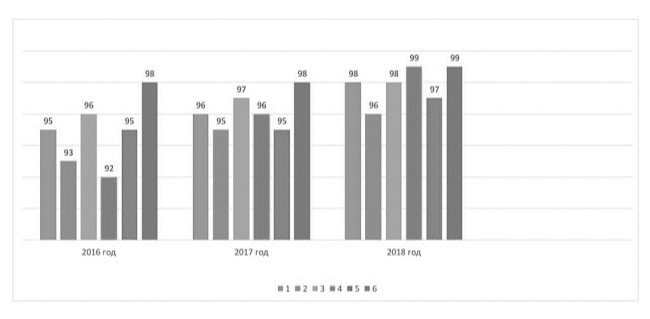
Rice. 2. Results of monitoring of integrative qualities
The obtained indicators allowed us to draw the following conclusion :
The share of pupils at the end of their stay in a preschool institution who have positive results in personal and social development over 3 consecutive years is close to 100%.
The obtained research indicators allowed us to conclude that the implementation of the created model contributes to the formation of integrative qualities in children with disabilities:
– the majority of graduates of correctional groups of preschool educational institutions have increased interest in subjects of the surrounding world, experimental and design activities, and use the information received in various types of activities;
– from 93% to 97% of children have ideas about themselves, their family, society, state, world and nature;
– 96% - 98% show independence and activity in everyday life;
– about 100% of students are able to negotiate, distribute actions, and change their communication style;
– all children with disabilities have begun to respond more adequately to external stimuli, are able to control their behavior, and comply with basic social norms and rules of behavior.
– 99% of preschoolers correctly understand and identify the various emotional states of peers and adults in real life and in fiction, and show compassion and care for loved ones and animals.
Evidence of the effectiveness of the work being carried out is the preservation and improvement of social and personal results during the transition to the next stage of training.
Monitoring of socialization showed that students have consistently positive dynamics. Children successfully adapt to a new social environment, gradually learn to build a strategy for independent living, establish new social contacts, and demonstrate a sufficiently high level of readiness for independent living.
We believe that this work experience on the topic “ An optimal model of socialization as one of the conditions for the successful social development of children with disabilities in preschool educational institutions” is relevant and recommended for specialists working with children with disabilities in educational institutions of various types , and is also used in the training and retraining of teachers in correctional work with children with disabilities.
Literature:
- Kolomiychenko L.V. “On the path of goodness” Program on social and communicative development and social education of preschool children. - M.: TC Sfera, 2015. - 192 p.
- The main educational program of preschool education “From birth to school”, ed. N. E. Veraksy, M. A. Vasilyeva, T. S. Komarova. -M.: Mozaika-Sintez, 2022. - 352 p.
- Triger R.D. Psychological features of socialization of children with mental retardation. - St. Petersburg: Peter, 2008. - 192 p.: ill. — (Series “To the Child Psychologist”).
- Socialization of children with disabilities at the present stage: scientific, methodological and applied aspects: Collection of scientific and methodological materials / ed. Belogurova A. Yu., Bulanova O. E., Polikasheva N. V. - M.: Sputnik+ Publishing House, 2014. - 335 p.
Key terms
(automatically generated)
: kindergarten, limited health, optimal model, child, single integrated space, social development, preschool institution, single integrated field, control period, research work.
Where can children with disabilities study?
Children with disabilities can attend specialized or regular kindergartens. The choice of group and institution depends on the severity of the child’s disabilities. There are two main training options.
1. Kindergartens or compensatory groups These are special groups that are aimed at correcting pathologies in children. They are usually attended by preschoolers with serious physical and mental disabilities. Children with similar types of disabilities are assigned to each group and are taught within the group according to a single program.
2. Combined groups This group combines normal children and preschoolers with disabilities. The group should have no more than 15-17 people. Moreover, there may be only a third of this number of children with disabilities. Combined groups are suitable for children with minor developmental disabilities. But it is also important to create special conditions for them. The teacher works with “special” children according to an individual adaptive program. If children have different types of disorders, then the development program is drawn up individually for each.
The decision on which form of education is suitable for a particular child is made by a psychological, medical and pedagogical commission. The student undergoes a full examination and receives a conclusion. In addition to the conclusion, recommendations are attached that indicate the conditions for the child’s comfortable learning.
Who is included in the HIA group?
By the way, if anyone wants to study the legal framework on this issue on their own, I can recommend the manual “Education of children with disabilities in accordance with the Federal State Educational Standard of the NOO. Local legal acts”, you can buy it on the portal “Labyrinth.ru”.
So, it is worth noting that a referral to a group for children with disabilities can be obtained after passing a special psychological, medical and pedagogical commission and only with the consent of the child’s parents or guardians. Considering the child’s rights to choose the form and method of receiving education, experts can only recommend that the mother transfer the baby to a special group.
The fact is that sometimes parents do not notice deviations in the child’s behavior, which indicate the presence of a certain disease that reduces his ability to receive education in the usual way. There are children who were born with obvious deviations in health and development, and there are cases when only by certain signs noticeable to a specialist can one determine the presence of some kind of defect.
You need to be very attentive to your children and, at the slightest suspicion, contact a specialist. After all, most minor developmental and health defects can be corrected and forgotten about, but only with early diagnosis.
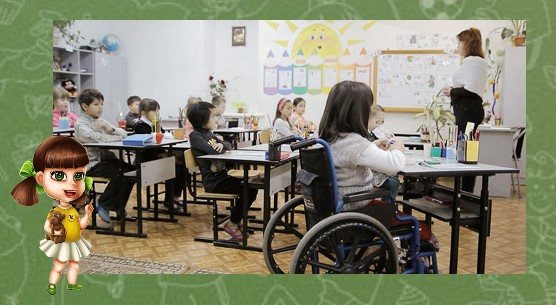
Children can be trained in a correctional group if they have the following defects:
- Impaired hearing, vision, speech;
- Mild mental retardation;
- Negative mental states;
- Psychopathic-like forms of behavior;
- Pedagogical neglect;
- Mild motor pathology;
- Complex forms of allergies;
- Frequently recurring general diseases.
It is worth noting that the listed pathologies should be in a mild form, but if the pathology is severe, the child simply physically cannot be outside the home and without his parents.
What conditions are needed for children with disabilities in kindergartens?
Children with disabilities, due to circumstances, get used to constant parental care, so it is difficult for them to adapt to society. They often have little interaction with other children and virtually no participation in group games. It is important to create an environment that will help children develop basic interaction skills. For example, prepare for life in society, develop speech, social and motor skills, as well as self-care skills.
To do this you need:
- Arrange the territory of the kindergarten in such a way that the child can move freely, regardless of possible physical limitations.
- Create a favorable atmosphere in the group, preparing healthy children for the arrival of a child with special needs. The teacher’s task is to create an environment in which every child feels comfortable, adhering to the principle of equality and without violating the rights of ordinary children. At the same time, it is important to ensure that a friendly atmosphere is maintained in the group. Encourage mixed games where kids play together, do not emphasize the differences of a child with special needs in front of other children. Be the bridge through which the child finds his first friends. Remember that the child’s psyche is flexible and very quickly takes for granted any characteristics of classmates in the garden if adults treat them calmly and kindly.
- Involve not only educators, but also other specialists in working with children. The program should include: a psychologist, speech therapist, speech pathologist, health worker, music director and physical education instructor. They evaluate the child’s behavior, his reactions to various situations, and conduct additional individual or group lessons. Then they observe the results, make the necessary recommendations and report them to parents. In this way, it will be possible to ensure the comprehensive development of the child - physical, artistic, speech and social.
- Study the characteristics of each child and the recommendations of the medical board. Based on this, create an individual development plan. Despite the possibility of joint education for ordinary children and children with disabilities, the forms and methods of education for children with a diagnosis differ from the standard ones.
Organization of work with preschool children with disabilities in preschool educational institutions.

Adapted educational program of preschool educational institution
This program, according to the Federal State Educational Standard, implements the training and education of children with disabilities in accordance with their development, characteristics, and individual capabilities. In addition, she corrects, if necessary, problems with the child’s adaptation to social society.
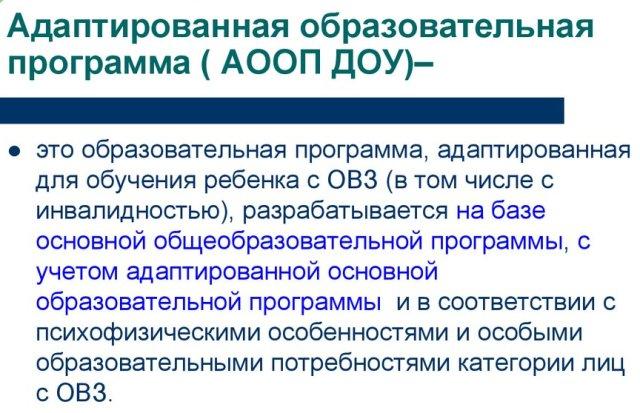
Individual correctional and developmental route for a child with disabilities
General methods for preschool education are not suitable for all students. For some, it is quite difficult to study according to such a program, for others, on the contrary, there is not enough knowledge for further development. For this reason, new training systems are being developed that take into account all the individual qualities of all children individually. They are presented in the form of an individual educational route for children with health problems in a preschool educational institution.
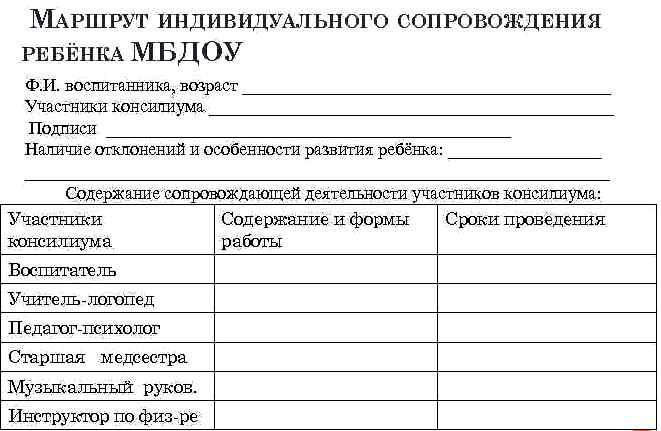
It is developed by specialists, gradually setting goals and objectives, using pedagogical resources, methodological techniques and the results of individual educational methods.
Forms and methods of work of a teacher with children with disabilities
During training, children with disabilities often get tired quickly, respond slowly to requests, and find it difficult to maintain attention on one task. These features should be taken into account when choosing a form of training. For example, you should reduce the duration of classes, change activities more often, and allocate more time to any task. But this does not mean that a child with disabilities needs to be separated from the main group. It is important to find abilities, identify the child’s predispositions and rely on them in learning.
The main task of the teacher in group work is to find those methods that will be accessible and interesting to all group members. Psychologists recommend including three main methods in your plan.
Play therapy
This is a psychological tool that influences children through play. In a relaxed atmosphere, children learn to interact with other people, explore the world and expand their horizons. The game helps to understand exactly what difficulties a particular child is experiencing and correct them.
Children with disabilities will benefit from musical games or exercises in the sensory room. This is a specially equipped room that helps stimulate all forms of perception: olfactory, tactile, auditory, visual, gustatory and vestibular.
Psycho-gymnastics
These are sets of exercises and games that help relax muscles, express feelings and become emotionally liberated. Such exercises develop the cognitive, emotional and personal sphere. The simplest example of psycho-gymnastics is the game “Do as I do.” The teacher shows expressive movements, and the children repeat.
Fairytale therapy and puppet therapy
Fairytale therapy allows you to immerse a child in a certain situation using the example of fairy-tale characters. In this way, he develops his imagination, learns to cope with fears and live through his emotions. Fairytale therapy is effective for children who have difficulties in the physical, emotional and behavioral spheres. Fairy tale therapy is a method of working with children through fairy tales. Puppet therapy works on the principle of fairy tale therapy, only instead of a fairy tale, the teacher performs a puppet theater.
Methodological help for teachers
Today, there are various forms of self-education, including literature, seminars, courses, etc. How to manage everything? You can take training online without leaving your home and receive relevant certificates that will not be superfluous in your portfolio.
I always find particularly advantageous offers for seminars at UchMag:
- “Development of fine motor skills in children with disabilities using non-traditional equipment”;
- “Federal State Educational Standards of the National Educational Institution: Correctional and Pedagogical Support for Children with Disabilities”;
- “Special education of children with special educational needs”;
- “Methods, techniques and forms of working with parents on the development and correctional pedagogical assistance to children with disabilities.”
What are the difficulties of working with children who are not entirely healthy?
The fact is that such children are characterized by some motor retardation or hyperactivity, insufficient coordination of movements, poor performance, low socialization, intellectual disability, deviations in cognitive processes, etc.

Usually the adaptation of such a child occurs with great difficulties, since there is low self-esteem and various fears. But at the same time, according to experts, one defect is compensated by an inflated positive quality in such children. For example, children who are hard of hearing have sharp eyesight and a great interest in fine arts. And visually impaired children have a well-developed so-called sixth sense.
To work with this contingent of pupils, it is not enough to just be a teacher with a standard preschool education. You need to take special courses, study a lot of literature on your own, study not only your responsibilities, but also delve into the psychology of these children, understand the peculiarities of their physical condition.
For each child with disabilities, a profile is written by each specialist who works with him. Periodic monitoring of the child’s development dynamics and health monitoring, both physical and psychological, are carried out.
In short, very difficult, but very important work is being done - correction of child health defects.
In simple terms, they simply work with children and teach them not to be shy, but to be successful in other activities among their peers. The teacher must pay attention to the abilities of the child and the students in the group.
Benefits and additional payments for teachers working with children with disabilities
Working with children with disabilities is additional work and responsibility for the teacher. Not every specialist has the appropriate professional and emotional preparation for such work. To work with children with disabilities, a teacher must undergo a professional development program and learn to use the acquired knowledge in their work. Therefore, the state encourages educators who help children compensate for deviations and become full-fledged individuals. Such specialists receive higher wages and longer vacation - 56 calendar days. On the contrary, the number of working hours decreases - they work no more than 25 hours a week.
If you found this article helpful, please rate it on the star scale below, with 5 stars being very helpful.
We want you to read only interesting materials, and we will be grateful for your feedback!
Features of working with children with health limitations
You need to understand that regardless of the state of the child’s physical and mental health, he has equal rights to receive an education, like other children. It’s just that an individual development program and a deeper focus on the child’s development are drawn up for children with disabilities.
To help myself and all my colleagues who work or plan to work in a correctional group, I selected thematic books in the same “Labyrinth”:
- “Inclusive education. A Handbook for a Teacher Working with Children with Disabilities" - this methodological guide with recommendations for overcoming developmental defects will be of interest to all interested parties;
- “Social and communicative development of children with disabilities in accordance with the Federal State Educational Standard” - a CD from the “Pedagogical Video Workshop” series contains materials on creating a developmental environment that will maximize the potential of each child.
Children with disabilities have the right and should be raised and developed in a group of their peers. For this purpose, special groups are created or such children are integrated into a regular group in the so-called mass kindergarten (as opposed to a specialized one). By the way, the stay of children with disabilities in kindergartens is free.
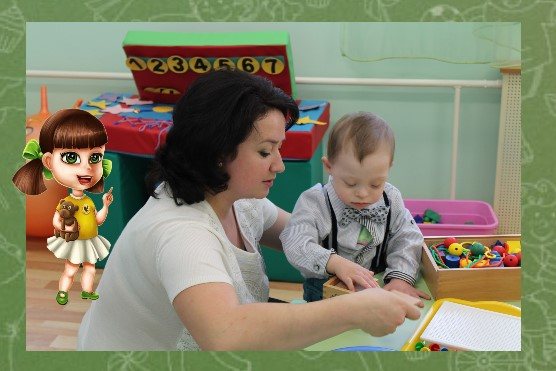
I really like the expression: creating a barrier-free development space. This is a succinct phrase, isn’t it, which characterizes the main task of a teacher who works with this group of children. We must do everything so that children with disabilities can receive full-fledged preschool education and education in a regular kindergarten.
The main feature of working with children with health limitations is the constant psychological, medical and pedagogical support of children by competent specialists who work closely with each other. Working with these kids involves a comprehensive search for ways to overcome defects and complete socialization in society.
Educators alone cannot solve the problem of correcting the physical or psychological problems of children. Only together we will overcome everything, including with the help of our parents. And this is not just my opinion, many experts with whom we took courses think so.
Directions of correctional work with children
Children who attend a correctional group are treated according to the same principle as with ordinary children, but taking into account the characteristics of this contingent.
Thus, much attention is paid to the following areas:
- Development of physical health. A physical education or physical therapy instructor develops an individual program for each child, which provides for the correction of certain physical defects.
The teacher, together with the psychologist, uses physical education as a tool to strengthen willpower, an active life position, motivates children to make independent decisions and develops the ability to get out of difficult situations. This strengthens the baby's emotional health and makes him stronger in every way.
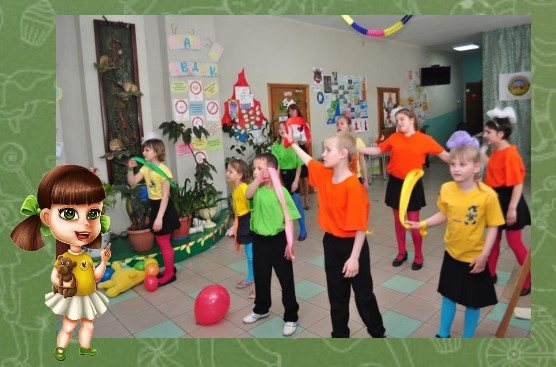
- Development of cognitive qualities. Using the principle from simple to complex, relying on the principle of clarity, other methods and techniques that are suitable for each specific child teach children the skills of independent exploration of the world. The difficulty is that each child has his own health and psychosomatic characteristics, so a careful selection of methodological tools is required.
- Social and communicative development. This is an extremely important direction specifically for children with disabilities. They need to be taught the most basic everyday things that will facilitate their socialization. Healthy children learn self-care and communication skills naturally, gradually.
Children with disabilities experience difficulties with the simplest actions and often have problems with speech. The speech therapist and teacher solve these problems on two fronts, working individually with each child. Both teachers and parents of children with disabilities participate in organizing a communicative and developmental environment. A separate area is educational work with mothers and fathers.
We are working together to teach everyday skills and communication skills.
- Artistic and aesthetic development. Through classes in music, drawing, modeling, etc. Children very effectively develop fine motor skills, master the skills of working with different materials, and learn to interact with the teacher and friends. Art is very important for such children; they are often extremely receptive to music and love everything beautiful.




